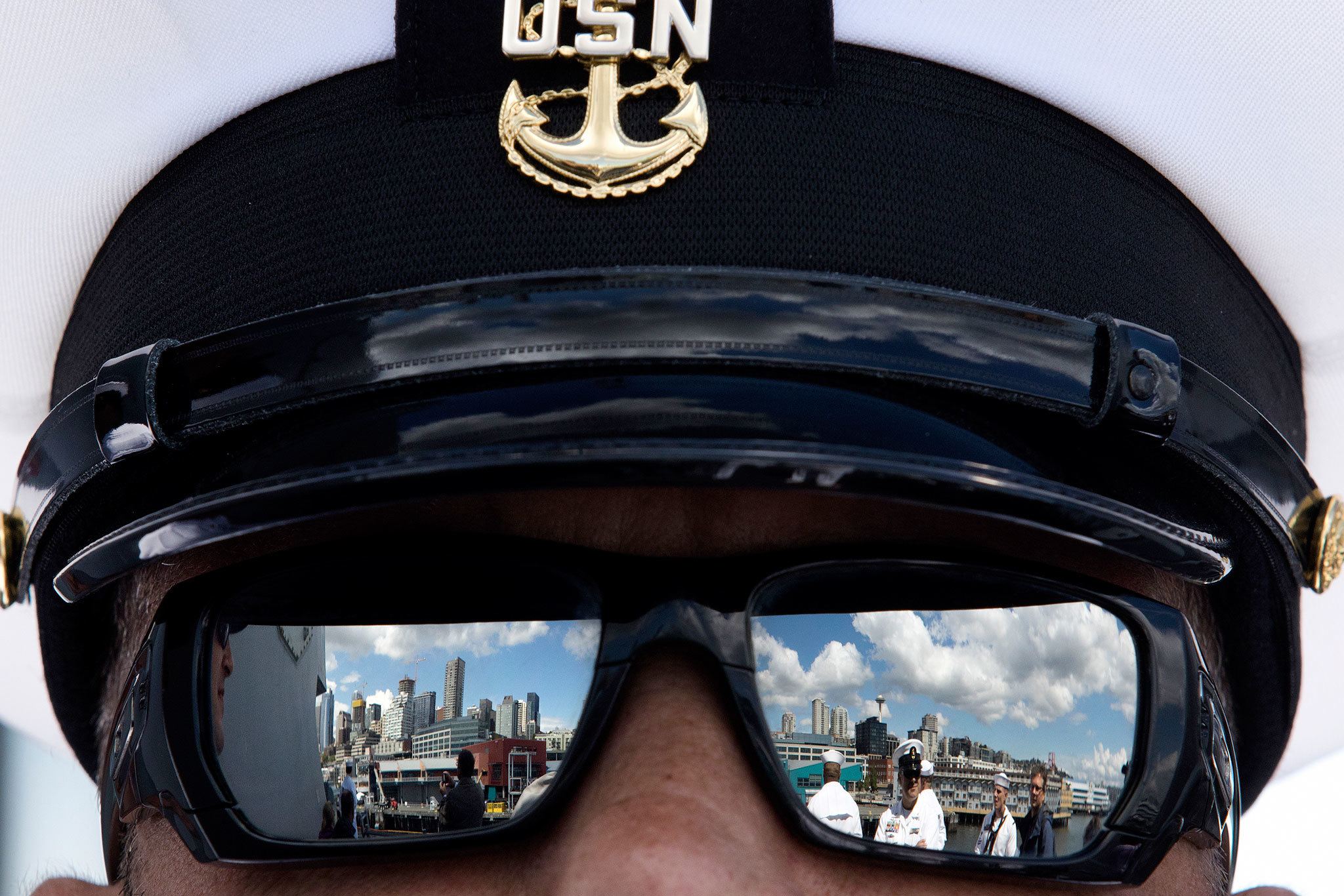ABOARD THE USS GRIDLEY — The foredeck of the USS Gridley swarmed with sailors as the ship prepared to depart Everett on Tuesday.
The sailors wore dress whites, and most had hard hats or warmer coats against the brisk, rainy weather.
Standing behind the main 5-inch gun was a small crowd of civilians, some with children.
The Gridley, an Arleigh Burke-class guided missile destroyer, was sailing from Naval Station Everett to Seattle to take part in the annual Parade of Ships for Seafair’s Fleet Week.
It was the Gridley’s second sailing since it arrived in Everett on July 9. The first sailing was across Admiralty Inlet to the ordnance storage facility at Indian Island Naval Magazine, said Cmdr. Marc Crawford, the ship’s captain.
The 509-foot-long ship is the first of four new destroyers of its class to join the destroyers USS Momsen and USS Shoup at their new homeport of Naval Station Everett. The other three, the USS Samson, USS Kidd and USS Ralph Johnson, are scheduled to arrive over the course of the next eight months.
The Gridley is the fourth U.S. Navy ship to be named after Capt. Charles Gridley of the USS Olympia, who was a hero of the Battle of Manila Bay in 1898 in the Spanish-American War.
He was the Gridley in Adm. George Dewey’s famous phrase, “You may fire when you are ready, Gridley,” which inspired the USS Gridley’s Latin motto: Ignis Ubi Paratus.
The nine-year-old warship is a much more advanced vessel than the steam-powered clunkers of the late 19th Century, however. Weighing 9,200 tons, its four gas turbine engines can put out 100,000 horsepower to the shaft.
Crawford explained what that means to a crowd of visitors. “We can get this ship going forward 30 knots, stop it within a ship length and go backwards,” he said. “These ships are so much fun to drive!”
Crawford has served aboard the Gridley since March 2014, at first as the executive officer. He became commanding officer last summer, when the Gridley was visiting Seattle for Seafair from San Diego, its former homeport.
In that time the ship went on a 10-month deployment to the western Pacific and the Middle East, one of the longest scheduled deployments since the Vietnam War. It also took part in a sinking exercise, in which a decommissioned vessel is used for target practice, and supported a Marine Corps training exercise with its main gun, firing 200 rounds in a single salvo.
“To do that without any problems with a gun, that’s what the Gridley does. Guns go boom, but guns break, too,” Crawford said. “It’s the crew that makes it happen.”
On Tuesday, the Gridley sailed to Seattle with a crew of about 300 sailors, including 37 officers. Its full complement is 360, which often includes the crews for two MH-60R Seahawk helicopters it can carry while deployed.
After the sailors detached the shore connectors and cast off the lines, the Gridley pulled away accompanied by two Navy tugs.
The lead ship in the formation was the USS Somerset, an amphibious transport ship visiting from San Diego. Bringing up the rear was the U.S. Coast Guard Cutter Active, whose homeport is Port Angeles.
Once the Gridley entered Possession Sound, it began to pick up speed, and the wind and rain quickly drove many visitors off the exposed decks.
On the bridge, the rumble of the engines was muffled, and the dozen or so sailors were able to talk without shouting, relaying commands and navigational directions at speaking volume.
At the mouth of Elliott Bay, the Gridley came to a near stop, and the population of the bridge suddenly doubled with crew coming in, donning headphones and standing by for the “sea and anchor” detail prior to docking.
The additional personnel are there to make sure that every part of the ship is in communication with every other, as well as other ships.
“(The procedure is) more modified when we’re so close to land, just a lot more cautionary measures we have to take,” said Petty Officer 3rd Class Arthur Pigg, a quartermaster on the bridge assisting with navigation.
“It gets pretty busy on the bridge,” said Pigg, who is from Puyallup.
As the ships pulled into the bay, the crew who were not engaged with running the ship came out to stand at attention in the traditional salute called manning the rails.
Chief Petty Officer Rosa Soares stood amidships directing other sailors to positions on the rails. Originally from Massachusetts, her tour with the Gridley has brought her to the Pacific Northwest for the first time.
She said San Diego doesn’t really have the equivalent of Seafair, despite its mammoth Navy Base.
“Usually they come up here,” Soares said.
Chris Winters: 425-374-4165; cwinters@heraldnet.com. Twitter: @Chris_At_Herald.
Talk to us
> Give us your news tips.
> Send us a letter to the editor.
> More Herald contact information.

























